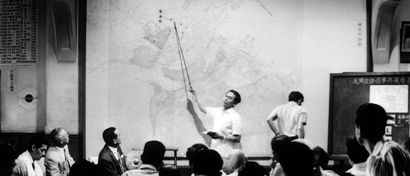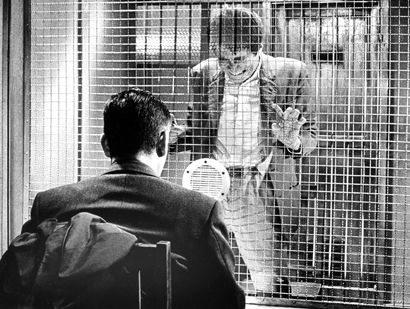
 |
|
|
|
The hardboiled crime classic High and Low (literally: Heaven and Hell) is one of Akira Kurosawa's most entertaining pictures. Toshiro Mifune once again creates an unforgettable character, a powerful but decent executive pitted against company sharks almost as vicious as those from Kurosawa's previous film, The Bad Sleep Well. The movie uses screen space to create a psychological effect. For the first forty minutes or so, we're stuck in the same room awaiting ransom phone calls from a formidable kidnapper. But a cut to a sleek bullet train announces the beginning of an exciting police manhunt covering an entire city. 
The story begins with a tense business meeting in an upscale home, as children play cowboy and outlaw with cap pistols. From his house overlooking Yokohama, hard-working up-from-the-factory shoe executive Kingo Gondo (Toshiro Mifune) is directing a careful takeover of his firm, a maneuver that requires fast moves with company shares and a large chunk of hard cash. When his small son is kidnapped, Gondo becomes frantic and agrees to pay the ransom ... only to find that the kidnapper (Tsutomu Yamakazi) has snatched his chauffeur's son in error. Decency demands that he use the money to free the servant's child as if it were his own. Gondo's sacrifice impresses the detectives on the case, who mount a vigorous campaign to catch the kidnapper. Adapted from an American crime novel, Kurosawa's film makes the most of dynamic social and spacial contrasts. Stranded in his lavish house, Gondo paces and worries, waiting for news from the kidnapper. After that static first section, the movie leaps to a frantic pace as an army of police agents turns the entire city upside down. The kidnapper Takeuchi has committed his crime out of bitter despair for the inequities between rich and poor. Economics force him to live in stinking, crowded slum housing. All the while he regards Gondo's white house on the hill -- the heaven he seeks to destroy. Like Satan, Takeuchi is a rebellious angel, committing crimes and murdering out of a warped desire to overturn society. It is therefore ironic that the target chosen by the kidnapper, although rich, is a cut above the predatory moneymen that adhere to cutthroat business practices. Kingo Gondo is at heart just a shoemaker dedicated to creating a superior product. He demonstrates his commitment to quality by tearing apart a proposed shoe model to show its shoddy construction. When the detectives need to hide a smoke bomb in the valise that will carry the ransom payment, Gondo goes right to work, spreading his old leatherworking tools across the floor of his soon-to-be repossessed living room. Takeuchi almost succeeds in bringing down the man on the hill. Kingo Gondo loses his business position, his house and all of his possessions. He's given up all hope of company ownership to save a little boy not his own. The chauffeur will do anything to repay the debt, and causes complications as the detectives close in on their target. Takeuchi, on the other hand, is infuriated by the sympathy given Kingo Gondo by the press. The kidnapper is driven to undertake new horrors, degrading himself even further. An extended sequence takes place in Yokohama's harrowing back-alley drug world. It's far more explicit than depictions in American films, where drugs were seldom portrayed in mainstream product. Kurosawa's film is a high-budget Toho production. Location shooting ranges all over the Japanese costal city of Yokohama. An impressive downtown set, all glass and showcases, is populated with hundreds of extras. Foreign sailors were recruited to represent the ugliest Americans imaginable, lolling with the Japanese good-time girls, rocking out to the blaring bands. Takeuchi is pursued through several levels of hell: indifferent hospital waiting rooms, downtown streets, nightclubs, the drug alleys ... and finally to an isolated Enoshima cottage on a garden hill over the ocean. It's as remote a Last Stop as the death shack in the film noir Criss Cross. Both seem to exist at the End of the Earth. 
Every scene is good in Kurosawa's film, but the best show an almost Utopian spirit of cooperation between the Japanese police and media outlets. The chief detective informs the press of his entire strategy and asks for their cooperation on a scheme to fool the kidnapper. The forty reporters agree, and in the communal spirit of cooperation not one of them exploits the situation -- something unthinkable today. Kurosawa again demonstrates his ease with his large and memorable cast. Among the detectives is a bald stage actor who had trouble performing on film. Kurosawa liked the actor so much that he slowed down production to accommodate his inexperience. High and Low introduced the bullet train to most Western audiences. Kingo Gondo must eject the ransom from an express speeding at over 100 miles per hour. Clever plotting brings Gondo and Takeuchi within a few feet of one another on the city street. A pair of cars winds slowly through the hills, just missing one another, making for a very different kind of suspense scene. High and Low ends with a stark face-off across a wire screen in a prison visiting room. The image is an example of graphic simplicity at its best, capturing both the film's reality and its social theme. A reflection in a sheet of glass superimposes kidnapper over victim, suggesting their souls are equal even if they themselves are polar opposites. Not since I Am a Fugitive from a Chain Gang has a crime film ended with such an inhuman shriek, like the sound of a damned soul. The exciting High and Low is an excellent starter film for viewers unfamiliar with Japanese cinema. The Criterion Collection's Blu-ray upgrade of High and Low follows a DVD remaster by only three years, and appears to be the same good B&W transfer. The image seems on the bright side and slightly lacking in detail compared to other Toho-derived Criterion Blu-rays. The stereo surround audio is an original 4-track mix from 1963. Stephen Prince provides the audio commentary, distilling forty years' worth of praise for this film into a single narrative. 
The main extra is a making-of docu from a Japanese TV show called Toho Masterworks Series. Kurosawa went to extravagant lengths to achieve realism, including using several different sets for Gondo's house. For night scenes, a set was built with a vast cityscape miniature beyond the picture windows. Kurosawa filmed the train sequence in real time with seven cameras and dozens of extras working in close confinement with the nervous Mifune. When one of the cameras jammed, a second 100-mph pass had to be rigged from scratch. To get a clear view of the kidnapper from the moving train, Kurosawa had a roof removed from a garage near the tracks. Interestingly, the Japanese TV show regards Kurosawa's "drug hell" sequence as unrealistic and weak; it must be referring to the scene's essential theatricality. Many of the film's extended dialogue scenes have six or eight characters on screen at a time, and Kurosawa often blocks their movements and poses in a slightly theatrical manner. In the nightclub and drug hell scenes High and Low's surface style shifts from docu realism into unearthly delirium. Toshiro Mifune is seen on a talk show, being chatty with a respectful hostess who kids him about his reputation for extreme cleanliness. Actor Tsutomu Yamazaki remembers being given careful handling by Kurosawa, and wearing those mirrored sunglasses to play the depraved kidnapper. Also included are two trailers, an essay by Geoffrey O'Brien and a remembrance from the set by Donald Richie. The disc producer for Criterion is Abbey Lustgarten.
On a scale of Excellent, Good, Fair, and Poor,
High and Low Blu-ray rates:
Reviews on the Savant main site have additional credits information and are often updated and annotated with reader input and graphics. Also, don't forget the 2011 Savant Wish List. T'was Ever Thus.
Review Staff | About DVD Talk | Newsletter Subscribe | Join DVD Talk Forum |
| ||||||||||||||||||